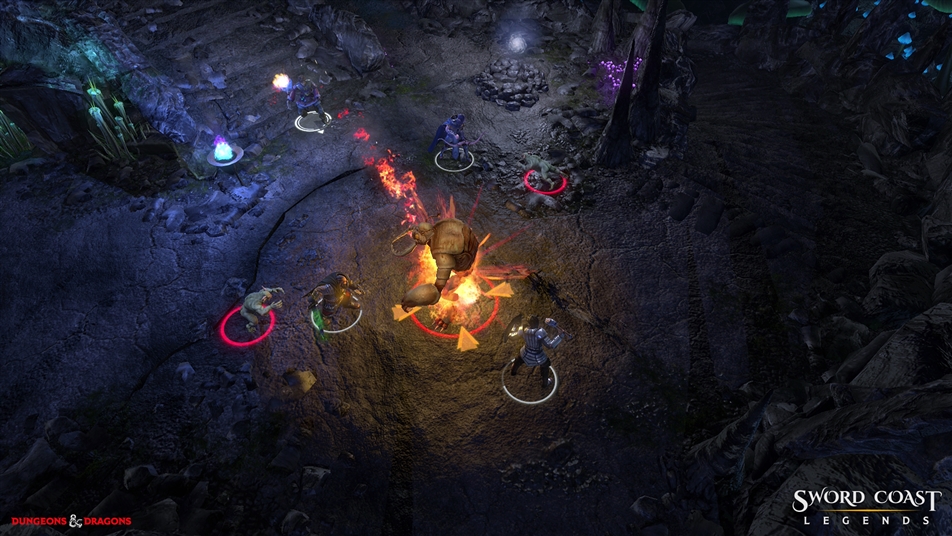The 90’s-style CRPG has been slowly making a comeback in the industry, thanks in part to the rising indie game developer movement and crowd funding programs like Kickstarter. Middle budget, bird’s eye/isometric dungeon crawls are the toast of the town again, with Shadowrun Returns and Pillars of Eternity reminding us that great games often do best when they embrace the past.
Considering the popularity of the license in these sorts of RPGs in the past, it’s sort of ironic that only now has there been a return to the genre by the Dungeons and Dragons brand. The Forgotten Realms made the perfect setting for a video game, evidenced by just how many games that were made based on the lore and locations. With Sword Coast Legends, the dungeon crawling experience that the Wizards brand made famous in the PC landscape returns, bringing with it a tempest of innovation and potential to change the genre yet again.

My short time with the beta revealed a smattering of features that could really change the game for RPGs going forward, all centered around idea of handing full creative control over to players. Character customization is robust not just visually, but mechanically. There are a great deal of class and race combinations to create, all retaining the racial bonuses and setbacks from the table top RPG. The points buy system tasks you with making hard choices about what stats to focus on at the expense of others. It’s not an exact replica of the pen and paper game, but it’s a faithful reinterpretation.
I spent most of my time putting my ranger through his paces in the Dungeon Crawl mode, which spits out randomly generated dungeons based on your specifications. The amount of these specifications are pretty vast. Not only can you change the sorts of monsters you’ll meet by type – human mercenaries, goblins, cultists, etc. – but you can change the size of a dungeon, the complexity of navigating through it, and how many floors it will be. You can also add generic objectives, like finding an item or killing a boss, all with a few simple menu selections.
You can plunder these places solo or with friends. People can migrate in and out of your games, which can be both a blessing and a curse. It’s somewhat inconvenient if another player enters because the only loot being shared is gold, so everything they pick up is something you have no shot at. But an active human in your party helps when the going gets tough in dungeons. And it will.

It’s very easy to get overwhelmed when going into any particular dungeon alone. Combat is pretty standard for the genre, point and click to attack, hit numbered abilities, and wait for them to get off cool down, etc. But the action is noticeably slower than other games, and they deal in smaller numbers, just like D&D. My ranger’s 26 health would vanish pretty quickly when more than one goblin would wail on me at once. Bring help, and if you can’t find real players, there are a set of four NPCs you can invite to your party at any time.
For people looking for a more concrete and fulfilling adventure, there are far more in-depth creation tools at your disposal. Taking the quick select options of Dungeon Crawl mode to the next level, Sword Coast gives players the means to make their own adventures. You can make NPCs and vendors, change dialog and tell your own stories, create quests and enemies – all for unsuspecting players to trek through and attempt to conquer. There are already a bunch of modules available for download via the in game client, and some are real standouts like the Lost Mine of Phandelver by WombatChainsaw, or The Bride by Mourk. It’s like Super Mario Maker, but with more loot.
The crown jewel of this game has to be the DM mode. Imagine the concept of creating a dungeon for a party of players to adventure through, but adding all of the challenges and on the fly. Using a regenerating resource called Threat, one player plays God, spending Threat to add traps and bad guys to antagonize the party. You react in real time to a party’s progress, just like you would if you were all huddled around a table of miniatures. This is the link between table top RPG and video games that has been missing all these years, and my limited experience with the mode has given me nothing but hope for it in the future.
Sword Coast Legends releases in full on October 20th, 2015. For more information about the game, come to the Official Sword Coast Legends wiki.
